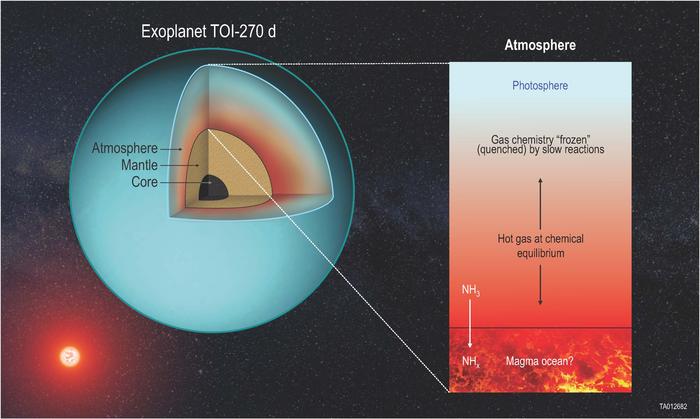In a groundbreaking study led by researchers at the Southwest Research Institute, a new geochemical model sheds light on the mysterious nature of TOI-270 d, a sub-Neptune exoplanet located approximately 73 light-years from Earth. This exoplanet, positioned between the size ranges of Earth and Neptune, challenges long-standing notions about planetary composition and atmospheric dynamics. The research, published in the Astrophysical Journal, utilizes data from NASA’s James Webb Space Telescope (JWST) to reveal that TOI-270 d is likely a super-Earth enveloped by an extraordinarily thick and hot atmosphere, rather than a temperate ocean world as previously hypothesized.
Sub-Neptunes have long puzzled astronomers and planetary scientists because they possess no analogs in our solar system. These planets are more substantial than the largest rocky planets we know but smaller than the gaseous giants like Neptune. Understanding their atmospheric chemistry and internal structure is key to unlocking the secrets of planetary formation and potential habitability beyond our solar neighborhood. TOI-270 d, one such sub-Neptune, stands as a kind of Rosetta Stone, offering invaluable clues about a prolific but poorly understood class of planets.
The study’s lead author, Dr. Christopher Glein of SwRI, emphasizes the significance of these findings in the broader context of exoplanetary science. The JWST’s unprecedented sensitivity allowed the detection of key atmospheric constituents — including carbon dioxide, methane, and water vapor — enabling scientists to develop a refined geochemical portrait of TOI-270 d. Unlike previous assumptions that framed such exoplanets as ocean worlds with hydrogen-rich atmospheres, the new model suggests TOI-270 d possesses a giant rocky core surrounded by an intensely hot gaseous envelope, with temperatures soaring above 1,000 degrees Fahrenheit. This condition surpasses even the scorching Venusian surface temperature, indicating complex thermal and chemical processes at play.
One of the most striking discoveries from JWST observations is the apparent absence of ammonia in TOI-270 d’s atmosphere. Ammonia was expected to be abundant in thick atmospheres dominated by hydrogen. However, this anomaly has been reconciled via the model’s inclusion of a magma ocean beneath the atmosphere. This molten rock ocean, theorized to exist on the planet’s surface, acts as a chemical sink, absorbing ammonia and altering the atmospheric chemistry dynamically. Such a mechanism not only explains the ammonia paucity but also points to hitherto unknown interactions between a planet’s interior and its outer gaseous layers.
The geochemical model further indicates that nitrogen gas production at these elevated temperatures, combined with the dissolution of ammonia into the magma ocean, dramatically reshapes the atmospheric composition. Intriguingly, the researchers also propose that TOI-270 d’s nitrogen content might be intrinsically low, owing to the nitrogen-poor nature of the planet-building materials—chondritic meteorites—in its formative environment. This insight advances our understanding of how initial planetary building blocks influence atmospheric evolution over geological timescales.
The giant rocky super-Earth characterization of TOI-270 d is pivotal because it nuances the classification of sub-Neptunes, suggesting a continuum of planet types bridging terrestrial and gaseous worlds. The concept of "Hycean" worlds—ocean planets with hydrogen-rich atmospheres situated in their stars’ habitable zones—has excited scientists as potential abodes for life. However, JWST’s data on TOI-270 d implies that simpler, yet hotter and more geochemically complex scenarios prevail in at least some sub-Neptunes, shifting the paradigm away from habitable models in certain cases.
Dr. Glein likens the emerging complexity of exoplanetary atmospheres to the diverse expressions found in biology: a handful of fundamental rules and ingredients can lead to remarkable chemical diversity. The study highlights how intricate geochemical processes, such as atmospheric equilibration at extreme temperatures and magma ocean-interactions, contribute to a planet’s unique atmospheric fingerprint. This approach marks a leap forward in applying terrestrial solar system geochemical methods to distant exoplanetary environments.
The ability to detect such fine compositional details on a relatively small exoplanet is a testament to the JWST’s revolutionary capabilities. Previous telescopes could barely constrain broad atmospheric characteristics on faraway planets, but JWST’s spectroscopic precision permits detailed chemical inventory taking. This opens the door to a new era where exoplanet atmospheres become laboratories for studying planetary formation, migration, and evolution under diverse astrophysical conditions.
While the current findings temper some hopes of habitability on TOI-270 d, they simultaneously invigorate interest in exploring alternative planetary formation pathways and atmospheric phenomena. The research underscores the vast diversity in planetary systems and the sophistication required to decode their stories. Each new exoplanet studied brings surprises that challenge and enrich our theoretical frameworks, compelling scientists to embrace both complexity and nuance.
The study also underscores the importance of integrated research methodologies, combining observational astronomy, laboratory chemistry, and sophisticated geochemical modeling. This multidisciplinary approach allows for a holistic understanding of exoplanet systems, bridging gaps between data collection and theoretical interpretation. The insights from TOI-270 d serve as a pilot for future investigations into other sub-Neptunes and smaller exoplanets, which constitute the majority of planets discovered in the galaxy.
Looking ahead, the research community anticipates applying similar models and analysis techniques to the thousands of confirmed exoplanets to date and those yet to be discovered. Each system will provide its own chemical story, some possibly resembling Earth, Venus, or Neptune more closely than others, but many will undoubtedly defy our expectations. Investigations like this set the stage for deciphering the grand tapestry of planetary origins and diversity that exist beyond the confines of our solar system.
Ultimately, the findings on TOI-270 d exemplify the rapid evolution of exoplanetary science. As Dr. Glein aptly notes, the expanding inventory of exoplanets paired with advancing observational tools like JWST fuel a new frontier for understanding the cosmos. We stand at the threshold of an era where alien worlds are no longer mere points of light but detailed entities with complex geochemical narratives, enriching humanity’s quest to comprehend its place in the universe.
Subject of Research:
Not applicable
Article Title:
"Deciphering Sub-Neptune Atmospheres: New Insights from Geochemical Models of TOI-270-d"
News Publication Date:
May 20, 2022
Web References:
https://arxiv.org/abs/2504.09752
https://www.swri.org/markets/earth-space/space-research-technology/space-science/planetary-science
Image Credits:
Southwest Research Institute
Keywords
Exoplanets, Habitable planets, Atmosphere, Planetary surfaces, Chemical modeling, Astrochemistry




